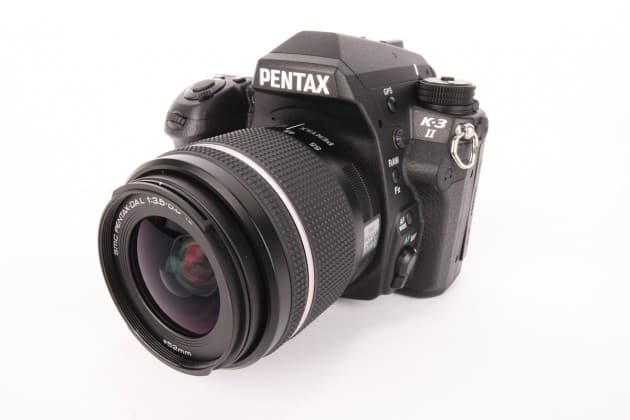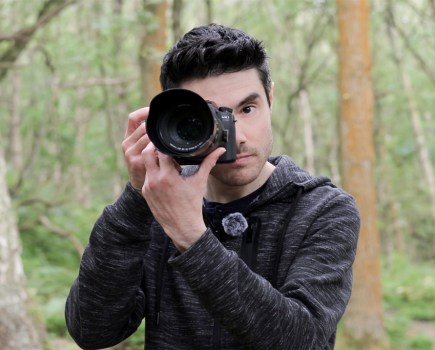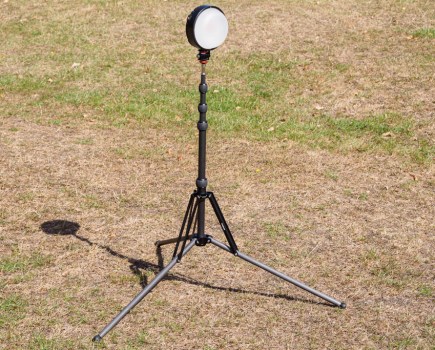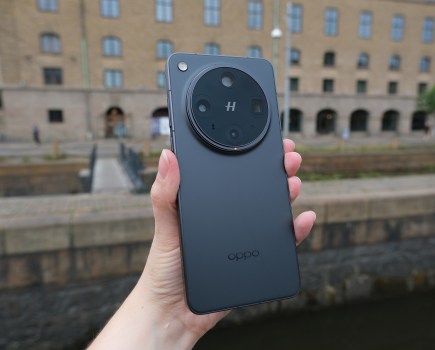At a glance
- 24.35-million-pixel CMOS APS-C sensor
- ISO 100-51,200
- 3.2in 1,037,000-dot resolution TFT LCD
- 8.3fps continuous shooting
- 27-point auto focusing system
- Price £769.99 (body only)
After nearly two years, Ricoh has updated the Pentax K-3 with a second version, the Pentax K-3 II. Designed to be the flagship Pentax APS-C DSLR, the K-3 II sits at the very top of the K-series of DSLR cameras.
Many of the original Pentax K-3’s great features remain, such as the robust weather-sealed body construction with distinctive large grip, the same 24.35-million-pixel CMOS sensor, 27 AF points, 8.3fps shooting speed and 86,000-pixel metering system.
However, there are also a few key differences. The pop-up flash has been removed to house a GPS unit as well as a unique Astrotracer, designed for taking photos of the stars and planets. There’s also a high-resolution Pixel Shift Resolution mode, improved 4.5-stop in-body image stabilisation and better continuous focusing.
While it faces stiff competition for the title of best APS-C DSLR from the likes of the Canon EOS 70D, the Nikon D7200 and the Sony Alpha 77 II, does the K-3 II hold a place as the best all-rounder?
Pentax K-3 II Review – Features

The Pentax K-3 II features an APS-C-size 24.35-million-pixel CMOS sensor – the same as that of the original Pentax K-3.
A feature unique to Pentax is how it works around issues to do with the anti-aliasing filter. Many camera manufacturers have removed the micro-blurring anti-aliasing filter to give images more detail, while risking the appearance of moiré patterning. Others avoid moiré by keeping the anti-aliasing filter, and instead choose to sacrifice some finer detail.
Pentax has an ingenious solution: it has an anti-aliasing simulator function that reduces moiré by using the in-body image stabilisation system to blur the image a tiny amount.
To allow photographers to balance the advantages of capturing finer detail against the effects of aliasing, depending on the type of subject they’re shooting, three settings can be found in the menu; namely Off, Type 1, and Type 2, with the latter giving a larger anti-aliasing effect. The problem is knowing in advance which would be best for any specific subject, and to this end, a bracketing mode takes shots sequentially at the three settings, so you can select the most appropriate afterwards.
The in-body image stabilisation itself – called Shake Reduction by Ricoh – has been upgraded, and thanks to a new high-precision gyro sensor, it now achieves 4.5 stops of stabilisaton, compared to 3.5 stops on the K-3 (both cameras were rated using CIPA standard testing). As usual, it works with all lenses. For those shooting in lowlight or anyone handholding the camera for shots at slow shutter speeds, this is an incredibly useful feature you won’t see on DSLRs outside of the Pentax brand.
The Pentax K-3 II offers an ISO sensitivity range of 100-51,200, and files can be captured in either JPEG or 14-bit raw formats. Like other Pentax cameras, users can either shoot in Adobe DNG or Pentax PEF format when it comes to selecting raw files. Adobe DNG is advantageous for some, as it works with older versions of software and allows many users to edit raw files without downloading further software.
Both the K-3 and K-3 II’s PRIME III processing engines support shooting at an impressive maximum speed of 8.3fps in Continuous H mode for a total of 60 JPEGs or 23 raw images.
In Continuous M mode, a rate of 4.5fps allows for a total of 100 JPEGs or 23 raw, and Continuous L mode gives a speed of 3fps and allows 200 JPEGs or 53 raw images to write to the card before the buffer is full. For comparison, this sits above the Nikon D7200’s 6fps shooting speed but below the 12fps of the Sony Alpha 77 II.

In-body image stabilisation upgrades enhance the K-3 II’s low-light potential
Where the Pentax K-3 housed a pop-up flash on its top, the K-3 II has instead made room to fit a GPS unit (previously, the Pentax O-GPS1 was a costly optional extra). Used to track and add geographical locations to your photos, GPS allows photographers to look back at the places they’ve visited and isolate where they took a particular shot.
In the K-3 II, Pentax has taken it one step further and ensured the GPS tracker works with a feature called Astrotracer. If you’ve ever tried to take a long-exposure shot of the night sky, you’ll have likely come up against the stars blurring in an arc due to the Earth’s rotation. Using the sensor’s stabilisation motors and the data gathered from the GPS, Astrotracer makes it possible to rotate the sensor to match the rotation of the earth. This allows users to achieve long exposures (up to five minutes) and track anything in the night sky including stars, planets, or nebulae.
There’s no Wi-Fi connectivity included, but there is compatibility with Eyefi SD memory cards and Pentax Flucards. Eyefi cards allow users to wirelessly transfer images and videos directly to their smartphone or tablet, while the Pentax Flucard offers the option of wireless remote control of the camera on a smart device, including live view.

While the Flucard is able to give the K-3 II Wi-fi functionality, in use it’s a little clunky
However, it’s rather slow, laggy and can’t compete against the Wi-Fi we see on many cameras today. After seeing proper Wi-Fi and NFC connectivity included on the Pentax K-S2, it’s disappointing to not see it in the K-3 II.
Video can be captured on the Pentax K-3 II at Full HD resolution of 1920×1080 pixels, and at a choice of frame rates including 60p/50p/30p/25p/24p, while 1280×720 pixel resolution is also offered at 60p/50p/30p/25p/24p. Additionally, there are standard mic and headphone ports included on the camera body, allowing capture of higher-quality audio.
Build and Handling

The K-3 was praised for its design, and the K-3 II continues in that tradition
One of the Pentax K-3 II’s standout features is its high-quality body design. Dust- and weather-sealed using 92 special sealing parts, it’s among the most rugged of all APS-C DSLRs and it claims a working temperature range between -10°C and 40°C.
Pentax also has a large range of weather-sealed lenses to match the K-3 II, which include the numerous kit lens options that come with the camera.
The body’s construction consists of a metal chassis with a magnesium-alloy shell, which is strong but not overly heavy. Weighing 800g with the battery and card, it’s 125g heavier than the Nikon D7200, which has a similar construction and level of weather-sealing.
At 131.5×102.5×77.5mm, the K3 II is a large camera, and, due to its stabilisation system, the depth from the front to the LCD is much longer than many DSLRs. Furthermore, the grip is 72mm from back to front, making it one of the deepest available. It certainly feels large in hand.
This large depth and grip mean that your hand feels stretched around the camera, rather than loosely curled around the grip.

You can see the deep grip, which makes the K-3 II comfortable to hold
This isn’t necessarily a bad thing: its snug fit and finger-shaped grooves allow your middle finger to sit perfectly inside the deep recess under the shutter button and make it feel like it’s designed to fit into your hand – giving it a very different handling experience to other DSLR cameras.
However, while the majority of photographers will really like it, I found it took some time to get used to, and it felt awkward after the more traditional, looser grips of other enthusiast DSLRs.
One of the strengths of the Pentax K3 II is the sheer number of buttons for changing different shooting settings, which cover everything a user is likely to need for a day’s shooting. It’s a more comprehensive set of controls than Nikon or Canon, the K3 II’s direct competitors.
There’s a designated button for everything you could wish for including AF/MF, AF Mode, metering, GPS on/off, white balance, ISO, exposure compensation and more. The camera’s on/off button is located above the grip, allowing you to turn the device on and off quickly with one hand.

Photographers who prefer physical controls will find a lot to like about the K-3 II
Most of the buttons are logically placed and easy to press but I found that the ISO button was positioned awkwardly to the right of the exposure-compensation dial, making it difficult to adjust with my eye to the camera.
Also worth noting for left-eyed shooters, the back scroll wheel is located close to the bridge of your nose, which can be annoying.
With its bright colours and numbers, the Pentax menu system is unlike any other – it looks closer in design to a sat-nav menu than other camera menus. Once you become acquainted with it, however, it’s really easy to follow and all your settings are clearly displayed on the LCD.
While it doesn’t have the simplicity offered by the Canon or Nikon menu system, it does allow for great customisation of settings and is perfect for the more discerning enthusiast who’s more likely to use this camera anyway.
A slight bugbear I have is that with all the settings on the rear status display, it would have been more intuitive to tap a button and change settings from the LCD, selecting an option using the directional controller and turning the scroll wheel to change it. This isn’t possible; instead users have to use the buttons on the camera to change settings.
LCD/Viewfinder

I was very impressed with the LCD, which performs well straight out of the box
Pentax DSLRs are often praised for their pentaprism viewfinders with 100% coverage, especially in the lower end models where direct competitors’ viewfinders simply aren’t as good. While it’s more common at this level of high-end APS-Cs, that doesn’t take anything away from the K-3 II’s decent 100% viewfinder with 0.95x magnification.
Like you’d expect from a Pentax camera, it’s great to use and means that you’re able to see the entire scene you’re photographing through the viewfinder. A 3.2in 1,04-million-dot resolution TFT LCD display is also present and boasts the ability to change brightness, saturation and perform colour adjustments. I found that even straight out of the box, the camera was really good at giving true-to-scene colours. The resolution is responsive and perfectly sufficient for many photographers.
Inside the camera is a gyroscopic sensor that allows small electronic levels to be displayed for both vertical and horizontal orientation. It’s incredibly useful, especially when trying to shoot landscapes and architecture and allows you to line up everything perfectly straight without needing an additional accessory.
There’s no touch screen functionality or articulation to the K-3 II, and while this is to be expected on a rugged, high-end APS-C DSLR, some users may find the omission an issue.
Autofocus

The K-3 II has fewer focal points than some of its rivals
The Pentax K-3 II uses a SAFOX 11 TTL phase-detection sensor module, and the camera features a total of 27 autofocusing points. When compared with the likes of the Nikon D7200 and the Sony Alpha 77 II – which boast 50+ focus points – it can look a little under gunned. However, the K-3 II does have 25 cross-type focus points, which analyse vertical and horizontal details to achieve more precise and faster focusing.
In addition, the centre point and the one above and below it are designed to work at f/2.8, resulting in quicker autofocusing when using large aperture lenses. So, while the K-3 II may not have as many AF points as some other models, the 27 it does have are rather good and achieve quick focusing – and for most photographers, 27 should be more than enough.
Users can choose between AF single, AF continuous and manual focusing. In autofocusing modes, there’s a choice between Spot, Select, Zone Selection, Expanded Area and Automatic (across all 27 points).

The camera acquires focus quickly and accurately
Improvements have been made to the continuous-focusing system, and Pentax claims this is the fastest continuous-focusing camera of any of the K-series DSLRs. This is attributed to its state-of-the-art AF algorithm and the advanced Pentax Real-Time Scene Analysis system. This uses subject analysis information provided by the 86,000-pixel RGB colour metering sensor to improve AF tracking calculations in continuous shooting mode.
In use, the continuous focusing is quick at finding and keeping the subject in focus, although for sports and wildlife shooting, more focusing points would be preferable. For single focusing, it’s similarly speedy even in low light conditions and typically finds focus in a fraction of a second. In fact, it’s surprisingly fast in low light, often finding near-perfect focus and then honing it with small adjustments thereafter.
When using live view, focusing is slower overall – but in comparison to similar APS-C DSLR cameras it’s still rather speedy, finding focus reasonably quickly and accurately. In good light it’s very fast thanks to the contrast-detection AF.
Metering

Challenging backlit screens can require user intervention to get the exposure right
The 86,000-pixel RGB sensor featured inside the Pentax K-3 II takes care of calculating the metering. Like the majority of Pentax cameras, the K-3 II has a tendency to slightly underexpose some shots in the multi-segment and centreweighted average metering modes.
The camera appears to prioritise highlight detail, allowing users to bring out more detail from the shadows. This is certainly not a bad thing, as it utilises more of the camera’s dynamic range. On occasions, particularly with backlit scenes, the camera overexposed shots. I found the K-3 II needed regular adjustment of the exposure compensation to get the shot how I wanted it, more so than most APS-C DSLRs.
White Balance and Colour
All the usual settings you’d expect are included on the Pentax K-3 II including AWB, Shade, Daylight, Cloudy, Tungsten Light, Flash, CTE and Manual, as well as four Fluorescent Lighting options. There’s also the option in Custom Menu 2 to automatically adjust white balance, even when the light source is specified.
This means the camera can fine-tune the white balance to compensate for small differences between similar types of artificial light. Users can also adjust the bias of each white balance setting between blue, green, amber and magenta, should they want to.

Colours are punchy and true-to-scene
Colours outputted from the JPEG images are true to scene, rendering rich tones as vivid as you’d like. Occasionally, when shooting bright subjects such as flowers, the processing can deliver too much saturation and it’s worth tweaking the settings to taste.

Default JPEGs can be excessively vivid, but the different colour modes can help you to get your images looking just right
To add a little more punch, users can select one of the colour profiles featured on the K-3 II. Landscape mode gives a little more vibrancy to blue, red and yellow, delivering tonally rich skies. There are also settings such as Vibrant, Radiant and Cross Processing that deliver saturated images. For more subdued effects, the Bleach Bypass and Muted modes work well and, among the few other modes remaining, there’s also an effective Monochrome setting.
Pixel Shift Resolution System
New to the Pentax K-3 II is Pixel Shift Resolution, a mode designed to give better colour rendition, lower noise levels and resolve more detail. It does this by combining four exposures, moving the sensor by exactly one pixel between each in a square pattern. This allows it to record full colour information in the red, green and blue channels for each image pixel.
By doing this, the K-3 II no longer needs to interpolate colour at each pixel. However, unlike the Olympus OM-D E-M5 Mark II, it doesn’t increase linear resolution of the image.

This image was taken using Pixel Shift Resolution mode
Here are two 100% crops from the above image, the first taken without Pixel Shift Resolution, the second with it.
Without
With
As you can see, providing the subject is static, Pixel Shift Resolution mode can produce incredibly detailed images which outperform what any other APS-C sensor is capable of at present
As there are four exposures being taken at a time, a tripod should be used and the subject needs to remain static to avoid ghosting or blurring artefacts.
Image Quality

The K-3 produces great-looking images and is a pleasure to shoot with
Featuring a Sony-made 24.35-million-pixel APS-C sized CMOS sensor – likely to be the same as in the Nikon D7200 and Sony Alpha 77 II – the Pentax K-3 II image quality is very good. There are issues with the JPEG processing not rendering the finer detail of an image, but raw files have an excellent amount of detail present. It’s also quite remarkable how much detail the Pixel Shift Resolution mode can resolve, although it’s limited to static subjects.
Dynamic range is great, as we would expect, and it retains a good dynamic range throughout the ISO sensitivity range, giving plenty of detail in the highlight and shadows. I found shooting up to ISO 800 gave very good results, and luminance noise isn’t noticeable until ISO 1,600. Overall, raw image quality is up there with the best APS-C cameras available, but JPEG images don’t quite match up.
Resolution
With the anti-aliasing simulator switched off and shooting at the minimum ISO sensitivity of 100, a score of 3,300l/ph is gained from our resolution chart. This is a very impressive score for this type of sensor and it holds up well as the sensitivity is raised, with 3,100l/ph at ISO 6,400. However, while in Pixel Shift Resolution mode at ISO 100, an excellent total of 3,800l/ph is resolved. All the images were taken with a Sigma 105mm f/2.8 EX DG OS HSM macro lens at f/5.6.
Below are 100% crops from our resolution test chart shots. Multiply the numbers below the lines by 200 to give the resolution in lines/picture height (l/ph).
Native 24MP mode (AA simulator off)

Pentax K-3 II resolution (native) ISO 100

Pentax K-3 II resolution (native) ISO 1600

Pentax K-3 II resolution (native) ISO 51,200
Anti-aliasing mode 1

Pentax K-3 II resolution (anti-aliasing mode 1) ISO 100

Pentax K-3 II resolution (anti-aliasing mode 1) ISO 1600

Pentax K-3 II resolution (anti-aliasing mode 1) ISO 51,200
Anti-aliasing mode 2

Pentax K-3 II resolution (anti-aliasing mode 2) ISO 100

Pentax K-3 II resolution (anti-aliasing mode 2) ISO 1600

Pentax K-3 II resolution (anti-aliasing mode 1) ISO 51,200
Pixel-shift resolution mode
Pentax K-3 II resolution (pixel-shift resolution mode) ISO 100
Pentax K-3 II resolution (pixel-shift resolution mode) ISO 1600
Pentax K-3 II resolution (pixel-shift resolution mode) ISO 51,200
Dynamic Range

Pentax K-3 II dynamic range
Our Applied Imaging lab test chart shows that at a base ISO sensitivity setting of ISO 100, the K-3 II can achieve 12.3EV. This is a very good, but fairly standard dynamic range score for this type of sensor, and indicates raw files should contain plenty of recoverable shadow detail.
At ISO 1,600, a dynamic range of 10.8EV is achieved, which is still very impressive. When pushed past ISO 1,600, dynamic range drops by around 1EV per stop of ISO sensitivity increase thereafter.
Noise
JPEG images from the Pentax Prime III processor can have multiple issues which cause a lack of detail in images such as clipping in colour channels and in-camera noise reduction. However, it’s possible to control noise and achieve detailed images shooting in raw and post-processing.
At ISO sensitivities between ISO 100-800, there is some luminance noise present in the raw files but it’s very slight and only obvious at ISO 1,600 and above. I would happily use this camera right up to 6,400 without worrying too much about colour or luminance noise, but thereafter I would take measures to keep it lower.
Below are 100% crops from our test scene across the full range of ISO sensitivities.

Pentax K-3 II noise – ISO 100

Pentax K-3 II noise – ISO 200

Pentax K-3 II noise – ISO 400

Pentax K-3 II noise – ISO 800

Pentax K-3 II noise – ISO 1600

Pentax K-3 II noise – ISO 3200

Pentax K-3 II noise – ISO 6400

Pentax K-3 II noise – ISO 12,800

Pentax K-3 II noise – ISO 25,600

Pentax K-3 II noise – ISO 51,200
Verdict

When compared to the original K-3, it’s clear the K-3 II’s core credentials haven’t changed much. The real updates are the inclusion of GPS, an improved AF algorithm for continuous focusing and Pixel Shift Resolution and Astrotracer functions. Although it’s likely these features will be infrequently used, they do set the K-3 II apart. Like all multi-shot modes, Pixel Shift Resolution can only be used with static subjects but when it works, the results are brilliant. No other APS-C camera is able to deliver the same amount of detail.
However, image quality leaves a lot to be desired when you look at JPEGs straight out of the camera. The channels tend to clip on bright colours, often giving unpleasant hue shifts. Thankfully though, the raw files are very detailed and have a lot of information so allow users to process superb images.
When Ricoh released the K-S2, it added Wi-Fi, NFC connectivity and an articulated screen. It would have been nice to see these features on the K-3 II as well. Most of the K-3 II’s competition feature Wi-Fi and NFC, so it’s particularly disappointing not to see them here. The Sony Alpha 77 II and Canon EOS 70D also feature useful articulated screens. With this said, the K-3 II’s viewfinder and LCD are still very good.
The in-body stabilisation is brilliant and allows sharp results using slower shutter speeds with any lens. This is great for users with older Pentax K-mount lenses. Focusing in single and continuous is fast and, if you don’t need a large amount of AF points, it’s fantastic. For those shooting wildlife however, the Nikon and Sony options offer a lot more.
It’s obvious that the K-3 II is a camera that’s designed for the discerning photography enthusiast who knows what they’re doing and appreciates the set of features it has to offer. It’s not without faults, but it represents good value and a superb feature set that you can’t get from other manufacturers.









